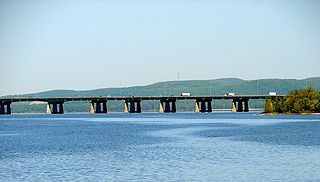
A coureur des bois or coureur de bois were independent entrepreneurial French Canadian traders who travelled in New France and the interior of North America, usually to trade with First Nations peoples by exchanging various European items for furs. Some learned the trades and practices of the indigenous peoples.

The Rivière des Mille Îles is a channel of the Ottawa River in southwestern Quebec, Canada and runs into the Rivière des Prairies. It is 42 kilometres (26 mi) long.

Saint-Eustache is an off-island suburb of Montreal, in western Quebec, Canada, west of Montreal on the north shore of the Rivière des Mille Îles. It is located 35 km (22 mi) northwest of Montreal.

This section of the Timeline of Quebec history concerns the events relating to the Quebec portion of New France between the establishment of the Sovereign Council and the fall of Quebec.

Deux-Montagnes is a suburban municipality in Southwestern Quebec, Canada on the north shore of the Rivière des Mille Îles where it flows out of Lake of Two Mountains. It is part of the Deux-Montagnes Regional County Municipality in the greater Montreal region. It is located 40 kilometres (25 mi) from Montreal.

Oka is a small village on the northern bank of the Ottawa River, northwest of Montreal, Quebec, Canada. Located in the Laurentians valley on Lake of Two Mountains, where the Ottawa has its confluence with the St. Lawrence River, the town is connected via Quebec Route 344. It is located 50 km west of Montreal.

Argenteuil—Papineau—Mirabel was a federal electoral district in Quebec, Canada, that was represented in the House of Commons of Canada from 1867 to 2015.

Lake of Two Mountains is part of the river delta widening of the Ottawa River in Quebec, Canada, at its confluence with the St. Lawrence River.

Route 344 is an east/west highway on the north shore of the Ottawa River in Quebec, Canada. Its western terminus is in Grenville-sur-la-Rouge at the junction of Autoroute 50, and its eastern terminus is in L'Assomption at the junction of Route 343. It follows the Ottawa River from Grenville-sur-la-Rouge to Saint-André-d'Argenteuil, where it follows the Lac des Deux Montagnes until Deux-Montagnes, where it follows the Rivière des Mille Îles until Repentigny, where it follows the Rivière l'Assomption until L'Assomption.
The Abbey of Notre-Dame du Lac, known as the Oka Abbey, was a Trappist Cistercian monastery located in Oka, Quebec. The main monastery building is of grey stone; it has a dozen outbuildings, all of which are situated on a 270-hectare property. With a decline in the number of monks by the early 21st century, the monastery decided to end operations there and established a non-profit centre at the abbey to preserve the site's heritage.

The Sir Wilfrid Laurier School Board is a school board headquartered in Rosemère, Quebec in Greater Montreal.

Jean-André Cuoq (1821–1898) was a Roman Catholic priest and a philologist in the Algonquin and Mohawk languages.

The North Shore is the general term for the northern suburbs of Montreal. The North Shore is located in southwestern Quebec on the northern shore Rivière des Mille Îles, opposite the Île Jésus. It consists of twenty municipalities that belong to the Laurentides and Lanaudière administrative regions. While the city of Laval is commonly associated with the North Shore, it is not considered part of the North Shore because of its status as an island.

Sainte-Marthe-sur-le-Lac is an off-island suburb of Montreal, in the Canadian province of Quebec, in the Deux-Montagnes Regional County Municipality, 40 km from Montreal. It is crossed from east to west by Route 344, commonly known as Oka Road. The town shares its borders with Deux-Montagnes to the east, Saint-Joseph-du-Lac to the west, the Lake of Two Mountains to the south, and Saint-Eustache to the north.

Pointe-Calumet is a municipality in the Canadian province of Quebec. The municipality is located within the Deux-Montagnes Regional County Municipality in the Laurentides region. It is situated about 30 minutes northwest of Montreal. Its population as of the 2021 Canadian Census is just over 6 000.
Deux Montagnes is French for "Two Mountains", and can represent:

Saint-Placide is a municipality in the Laurentides region of Quebec, Canada, part of the Deux-Montagnes Regional County Municipality, along the north shore of the Ottawa River.

Saint-Joseph-du-Lac is a municipality in the Laurentides region of Quebec, Canada, part of the Deux-Montagnes Regional County Municipality.

Coulée Grou is the name of an area in Montreal, Quebec, Canada, that was the location of a battle of the Beaver Wars, also known as the Iroquois Wars, given in honor of Jean Grou, a Canadian pioneer. Grou had sailed as a young boy from Rouen in France (Normandy) to New France circa 1650–1665 and established a land-holding at Rivière-des-Prairies–Pointe-aux-Trembles, east of the modern city of Montreal. At a battle here on 2 July 1690, Jean Grou and three farm workers were captured and burned alive.

The lordship of Lac-des-Deux-Montagnes was a seigneury in New France. It was located in the current regional county municipality of Deux-Montagnes Regional County Municipality in the administrative region of Laurentides in Quebec (Canada).


















